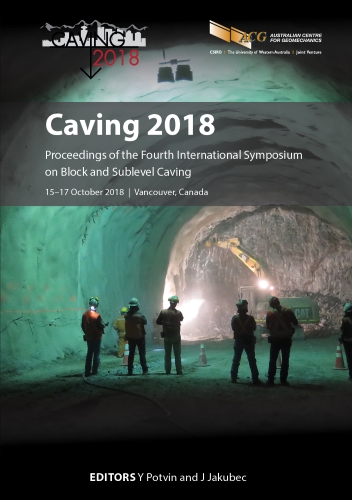Development and implementation of the Short Term Activity Tracker and Mine Control Trigger Response System

|
Authors: Chester, C; Cuello, D; Basson, G |
DOI https://doi.org/10.36487/ACG_rep/1815_40_Chester
Cite As:
Chester, C, Cuello, D & Basson, G 2018, 'Development and implementation of the Short Term Activity Tracker and Mine Control Trigger Response System', in Y Potvin & J Jakubec (eds), Caving 2018: Proceedings of the Fourth International Symposium on Block and Sublevel Caving, Australian Centre for Geomechanics, Perth, pp. 521-532, https://doi.org/10.36487/ACG_rep/1815_40_Chester
Abstract:
Seismic risk management at mining operations is predominately reliant on analysis and interpretation by ground control engineers, who must also manage all other mine site geotechnical hazards. Seismic systems run in real time collecting seismic parameters. However, the analysis, interpretation and resultant actions can be intermittent depending on available resources. Stress-induced seismicity during cave initiation and propagation is a constantly evolving hazard that requires a high level of continuous monitoring and examination. The authors have assisted in the development of integrated seismic monitoring and trigger response software applications within the Ticker3D seismic visualiser and analysis application, developed by the Institute of Mine Seismology (IMS). The benefits of the integrated applications include real-time monitoring of key seismic parameters and automatic trigger response, aiming to reduce workforce exposure to hazardous seismic conditions. Using measured ground motion as a monitoring input enables an almost immediate trigger response to a threshold breach via the Mine Control Trigger Response System. The continuity in seismic data interpretation and triggered mitigation controls are also recognised advantages to the applications.
Keywords: seismic risk management, TARP, ground motion, Short Term Activity Tracker, seismicity, mitigation controls, exposure
References:
Harris, PC & Wesseloo, J 2015, mXrap, version 5, computer software, Australian Centre for Geomechanics, The University of Western Australia, Perth, https://www.mxrap.com
Heal, DP 2010, Observations and Analysis of Incidence of Rockburst Damage in Underground Mines, PhD thesis, The University of Western Australia, Perth.
Heal, DP, Potvin, Y & Hudyma, MR 2006, ‘Evaluating rockburst damage potential in underground mining’, in DP Yale, SC Holtz, C Breeds & U Ozbay (eds), Proceedings of the 41st US Rock Mechanics Symposium, American Rock Mechanics Association, Alexandria.
Kaiser, PK, Tannant, DD, McCreath, DR & Jesenak, P 1992, ‘Rockburst damage assessment procedure’, in PK Kaiser & DD McCreath (eds), Rock Support in Mining and Underground Construction, A.A. Balkema, Rotterdam, pp. 639–647.
Mendecki, AJ 2016a, Mine Seismology Reference Book: Seismic Hazard, 1st edn, Institute of Mine Seismology, Hobart.
Mendecki, AJ 2016b, Development of Ground Motion Prediction Equation for Cadia East Mine, technical report, Institute of Mine Seismology, Hobart.
© Copyright 2025, Australian Centre for Geomechanics (ACG), The University of Western Australia. All rights reserved.
View copyright/legal information
Please direct any queries or error reports to repository-acg@uwa.edu.au
View copyright/legal information
Please direct any queries or error reports to repository-acg@uwa.edu.au
